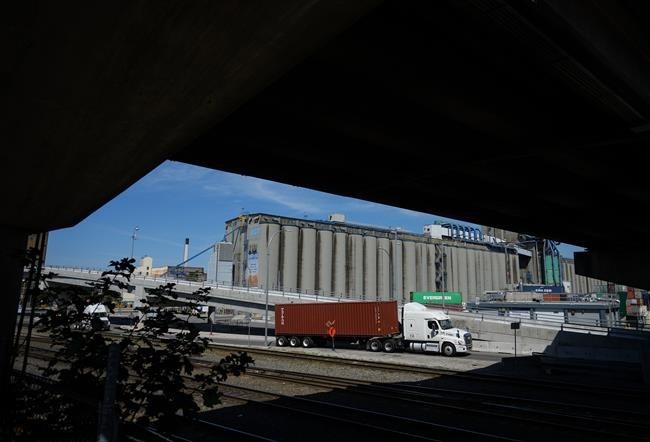For Jas Singh, the road to profit just keeps getting narrower.
“It’s slow right now, not too many loads," said the owner of JK Transport, a Brampton-based trucking company Singh launched 15 years ago.
On top of fewer shipments, costs have shot up while freight rates have plummeted.
A new tractor now costs him $225,000, up from the $135,000 he paid in 2019, Singh said. Trailers for his fleet of 15 semi-trucks have doubled in price to $80,000. And he can only charge $1.50 per mile for deliveries that reaped $2.30 per mile last year.
“A lot of problems this year," the 45-year-old said in a phone interview.
He's not alone. The entire Canadian trucking industry faces a shaky market as cargo volumes and rates continue to fall — in step with downward consumer demand — compared with the soaring highs seen during the pandemic.
The industry shed more than 20,500 driver jobs — seven per cent of the workforce — in the first three months of this year, according to a Trucking HR sa国际传媒 report.
"As the economy has essentially softened a little bit, so has demand for trucking services," said Craig Faucette, chief programs officer at the trade group.
While the contraction eases the labour shortage that has plagued the sector for years, it adds fresh woes to fleets already fighting for survival in a competitive landscape.
Canadians continue to shell out on services ranging from airfare to fine food, but their craving for items shipped in a box has fallen since 2021 and 2022.
"As things opened up, we saw a slight downturn as people returned to travel, restaurants ... as opposed to the items to renovate their houses or their backyards," said Mike Millian, president of the Private Motor Truck Council of sa国际传媒.
Inflation and rising interest rates have further cooled consumer demand. "You need less trucks to move it because there aren't as many goods moving."
Small companies with fewer resources and contracts are particularly prone to a downturn.
"You're seeing a lot of smaller fleets struggling, especially ones that rely on what we call the spot market," Millian said, referring to one-time shipments that fall outside long-term contracts or recurring schedules.
An even steeper drop in shipments in the United States has also dented Canadian trucker revenues, as drivers struggle to find loads to haul back to sa国际传媒 after making deliveries south of the border, he said.
“We wait for one to three days for it to come back," Singh said of his shipments to California, referring to the pre-load wait time.
Earlier this month, 94-year-old American trucking giant Yellow Corp. declared bankruptcy after years of financial struggles, a demise that John Gradek called "the tip of the iceberg."
"You have a number of carriers that are in very, very tight financial scenarios," said Gradek, who teaches supply chain management at McGill University.
So-called less-than-truckload (LTL) operations, which make multiple drops of cargo for different clients on a single run, face an especially competitive marketplace.
Rather than having stable contracts and regular income to fall back on, the "mom-and-pop shops" bid daily for shipments via a range of apps such as Freightera and FreightSimple, Gradek said.
Big companies rely on less-than-truckload businesses too. TFI International, the Montreal-based trucking giant with more than 25,000 employees and 11,000-plus tractors, gleans nearly half of its revenue from the segment.
"Our Canadian LTL revenue is down big-time," CEO Alain Bédard told analysts on a conference call Aug. 1, adding that the unexpected dip is not unique to that division. Total revenues plunged 22 per cent in the first half of 2023 compared to a year earlier, prompting the country's largest trucking company to lower its financial forecast for the second time this year.
"We never anticipated such a major, major disruption in the market in Q2," Bédard said. "Everybody's going through a sort of very tough patch in the freight environment.
He pointed to consumers: "They're not spending as much on the home or buying a TV or patio furniture."
The two-week strike by sa国际传媒 port workers last month threw an extra wrench into big-riggears across the country, he added.
Meanwhile, profit margins in a crowded industry grew even thinner. In the United States, freight rates for spot shipments decreased 23 per cent year-over-year in the second quarter and rates for contract shipments dropped 14 per cent, according to Coyote Logistics.
With constant cross-border hauls, Canadian trucking outfits typically see trends similar to those in the U.S., experts say.
The pinch comes amid ballooning operating costs, as diesel fuel prices tick back up toward 2022 highs, interest rates on truck leases rise and supply chain kinks persist.
Back in Brampton, Singh summed up the bottom line: "There's no profit right now."
This report by The Canadian Press was first published Aug. 24, 2023.
Christopher Reynolds, The Canadian Press



